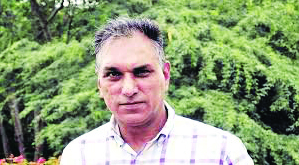

Chief Engineer
Chandigar UT Administration
He has been mandated to implement on-ground the ambitious vision that Chandigarh administrators have envisaged for the City Beautiful. Being the head of all the projects and their execution, Mukesh Anand, Chief Engineer, Chandigarh UT Administration, today holds vast grassroots experience, and shares it all in conversation with Priya Yadav of Elets News Network (ENN).
“Corbusier’s own office in Sector 19, where he used to work on designs of the city, has been converted into a museum that houses all the furniture he personally usedhis sketches, drawings and work plans.”
What kind of development can the residents look forward to under the Smart City Project?

We are looking at the holistic development of the City Beautiful (as Chandigarh is commonly described as). The city was developed in the 50s and what we are planning now, will rejuvenate it. There are a lot of projects underway to make it happen. For instance, Sector 17 (of the city), which has seen a decrease in the footfalls after a large number of malls have come up in and around the city, is all set to undergo a vast change. An urban park will come up behind the iconic Neelam Cinema, which will be sprawled in nine acres. The present stadium and open area around it will give way to the urban park that will have cycle tracks, open cafeteria, food court, skating rink and badminton court. An exciting feature would be provision for community watching of sports matches. Big screens will be put up in the urban park that will allow large spectators to enjoy cricket matches etc, together. Another project is to connect Sector 17 to Rose Garden through an underground subway.
What are the plans to make the city more accessible and easy to navigate for outsiders?

The most common complaint we faced in the past was that all the sectors in the city look just alike. The uniformity in buildings and common plan for all the sectors made it difficult for those coming out of the city to navigate easily. Now, under the Smart City Project, we have put smart signage at all the intersecting roads along with the logo of Smart City under it. The city has been comprehensively covered and the feedback from people has been very good. This has simplified its navigation and people can easily locate their destinations now.
The city has many heritage buildings built by its famous French architect Le Corbusier, what are the plans to conserve these?
We are very sensitive to the heritage that the city has. It has been built by a master – Le Corbusier- who was known to be par excellence and Chandigarh has many of his masterpieces. The Capital Complex has Heritage Grade I ranking given by the UNESCO. This is equivalent to that granted to the Red Fort. A massive conservation exercise is underway to conserve and preserve these buildings. The plan includes the Punjab and Haryana High Court, Secretariat, Assembly Hall, Open Hand – all of these will be preserved using latest techniques by March next year.
What are the tributes being paid to the memory of city’s famous architects?
We have meticulously conserved and preserved the legacy of its creators — Le Corbusier and his cousin Jeanneret. The house of Chandigarh’s first Chief Architect, Pierre Jeanneret, has been converted into a museum. The Swiss born architect Pierre Jeanneret, a cousin of Le Corbusier, designed most of the government housing, schools, colleges, shopping centres, Gandhi Bhawan, Panjab University. He lived in a self designed house in Sector 5 that has now been converted into a museum. Corbusier’s own office in Sector 19, where he used to work on designs of the city, has been converted into a museum that houses all the furniture he personally used-his sketches, drawings and work plans.
How is the urban mobility set to change?
A lot of options are being weighed to reduce the increasing congestion on roads. Metro rail was one of the options but now it is being seen if it is feasible at all. As an alternate transport plan, bicycle sharing is being planned. Cycle tracks are being made across the city, in several sectors the work is complete while in others it is still on. The city will be covered by over 10,000 cycles and their movement and operation will be monitored and controlled in a control room. This is the most environment-friendly and healthy way of commuting around the city. The city’s architectural design and compactness makes bicycle sharing a very feasible way of commuting.
Increase in the city population is making demands on power supply, how will this challenge be tackled?
We are going to put into place comprehensive IT network that will also help people get their power consumption pattern in real time. Smart meters are being installed that have several power saving features. For instance, it will generate and relay data of power consumption on minute-to-minute basis. Also peak time power consumption tariff will change. This will allow the consumers to study, analyse their consumption patterns and plan the use of gadgets judiciously.
Chandigarh is a green city and there is a plan afoot to have green buildings. What is that?
More emphasis is being laid on having buildings that are environment-friendly and green. Even the existing buildings are being fitted with solar power panels and energy efficient gadgets. A green and intelligent building is coming up by the UT Administration that will have all the features that are environmentfriendly. For instance, the bricks used for its construction would be ash bricks, the gadgets used will have five-star rating, it will be fitted with solar panels and will be energy efficient. It is part of a plan to have smart buildings
Be a part of Elets Collaborative Initiatives. Join Us for Upcoming Events and explore business opportunities. Like us on Facebook , connect with us on LinkedIn and follow us on Twitter, Instagram.











